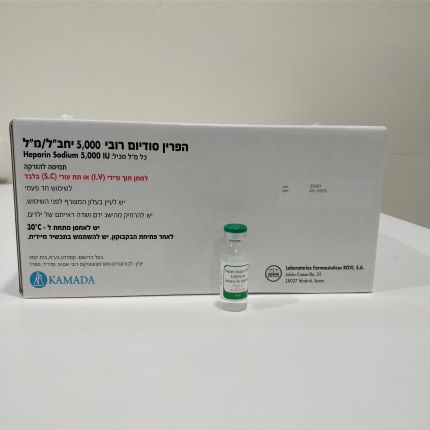Quest for the right Drug

הפרין סודיום רובי 5,000 יחב"ל/מ"ל HEPARIN SODIUM ROVI 5,000 IU/ML (HEPARIN SODIUM)
תרופה במרשם
תרופה בסל
נרקוטיקה
ציטוטוקסיקה
צורת מתן:
תת-עורי, תוך-ורידי : S.C, I.V
צורת מינון:
תמיסה להזרקה : SOLUTION FOR INJECTION
עלון לרופא
מינוניםPosology התוויות
Indications תופעות לוואי
Adverse reactions התוויות נגד
Contraindications אינטראקציות
Interactions מינון יתר
Overdose הריון/הנקה
Pregnancy & Lactation אוכלוסיות מיוחדות
Special populations תכונות פרמקולוגיות
Pharmacological properties מידע רוקחי
Pharmaceutical particulars אזהרת שימוש
Special Warning עלון לרופא
Physicians Leaflet
Special Warning : אזהרת שימוש
4.4 Special warnings and precautions for use Heparin Sodium Rovi 5,000 IU/ml should not be used in the case of: - suspected malignancy with a bleeding tendency. - renal or ureteric calculi. - chronic alcoholism. Particularly careful medical monitoring is necessary: - during pregnancy, especially in the case of prolonged use (see section 4.6). - in elderly patients, especially in women. - during concomitant treatment with fibrinolytics or oral anticoagulants, with antiplatelet drugs (e.g. aspirin, ticlopidine, clopidogrel) and/or glycoprotein IIb/IIIa receptor antagonists. - during concomitant use of medicinal products that increase the serum potassium level. Serum potassium levels should be monitored in at-risk patients (e.g. because of diabetes, impaired renal function or use of medicinal products that increase the serum potassium level). During treatment with heparin sodium, intramuscular injections should be avoided because of the risk of haematomas. If thromboembolic complications occur during heparin administration, type 2 heparin-induced thrombocytopenia must be considered in the differential diagnosis and the platelet count monitored. In infants, children and patients with renal and/or hepatic failure, careful monitoring and testing of coagulation parameters are essential; this also applies to the prophylaxis of thromboembolism (low-dose treatment). Patients on heparin therapy (of over 22,500 IU/day) should avoid putting themselves at risk of injury. Heparin can increase and prolong menstrual bleeding. If there is unusually heavy or acyclic bleeding, an organic cause requiring treatment should be excluded by a complementary gynaecological examination. In isolated cases, the occurrence of spinal and epidural haematomas has been reported in temporal association with spinal or epidural anaesthesia for unfractionated and fractionated low-molecular-weight heparin, especially in the case of intravenous administration or the administration of doses above those recommended for low-dose prophylaxis of thromboembolism (above 15,000 IU unfractionated heparin per day subcutaneously). These haematomas may lead to neurological complications of varying severity and even persistent or permanent paralysis. Heparin Sodium Rovi 5,000 IU/ml should therefore be used only after a detailed individual benefit-risk assessment if neuraxial anaesthetic procedures are planned or have already taken place. According to a recommendation by the German Society of Anaesthesiology and Intensive Care Medicine, a puncture-free interval of 4 hours should be left as a safety precaution between the last administration of Heparin Sodium Rovi 5,000 IU/ml at a prophylactic dose (low-dose) and re-insertion or removal of a spinal/epidural catheter. Thereafter, at least 1 hour should be allowed to elapse before the further administration of low-dose Heparin Sodium Rovi 5,000 IU/ml. Patients should be carefully monitored neurologically after the use of a neuraxial anaesthetic procedure, watching particularly for persistent sensory or motor deficits. If a haematoma in the region of the spinal cord is suspected clinically, suitable diagnostic or therapeutic measures should be initiated immediately. Notes on laboratory investigations: The platelet count should be checked: - before the start of heparin administration. - on the 1st day after the start of heparin administration. - then regularly every 3-4 days during the first 3 weeks. - at the end of heparin therapy. Heparin can distort the results of many laboratory investigations, e.g. the erythrocyte sedimentation rate, erythrocyte fragility and complement fixation tests. Heparin can affect the prothrombin time; this needs to be considered when switching to coumarin derivatives. The results of thyroid function tests may be distorted during heparin therapy (e.g. false high T 3 and T4 levels). Heparin Sodium Rovi contains benzyl alcohol Benzyl alcohol has been associated with the risk of serious adverse reactions (gasping syndrome) in newborn babies and infants. In infants (under 3 years of age), the medicinal product should not be used for longer than a week because of accumulation. Large quantities of benzyl alcohol should be used only with caution and when absolutely necessary because of the risk of accumulation and toxicity (metabolic acidosis), especially in individuals with hepatic or renal impairment and during pregnancy and lactation. Heparin Sodium Rovi contains sodium Heparin Sodium Rovi 5,000 IU/ml contains less than 1 mmol sodium (23 mg) per vial, that is to say essentially ‘sodium-free’.
Effects on Driving
4.7 Effects on ability to drive and use machines There are no known effects on the ability to drive or use machines.

שימוש לפי פנקס קופ''ח כללית 1994
לא צוין
תאריך הכללה מקורי בסל
לא צוין
הגבלות
לא צוין
מידע נוסף
